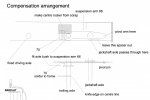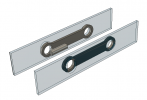Marc Dobson
Western Thunderer
I'm scratch building a GER 0-4-0 tram loco for my father's birthday present. Should I spring the chassis of leave it with solid wheel bearings?
Marc
Marc
It all depends of where your father wants to run it, Marc.It's a "Toby" loco. Drive is through normal rods. It's going to be RC so issues if pick ups don't exist. My S7 version has no compensation at all and runs fine. But the G1 version is still on the drawing board or should I say the chassis is as the top is a 3D print that was already drawn in 7mm and blown up to G1.
 David
DavidHi MarcSounds good where would I get my hands on some photos so I can draw something up?
Marc


Not really, other than to stop them flopping inwards. They need to be able to move up/down independently (the free end doing the same job as a hornblock), so better to have a simple staple or tab on each frame to stop the wondering inwards, but not to restrict their up/down movement.Would a cross beam linking the arms benefit anything?
